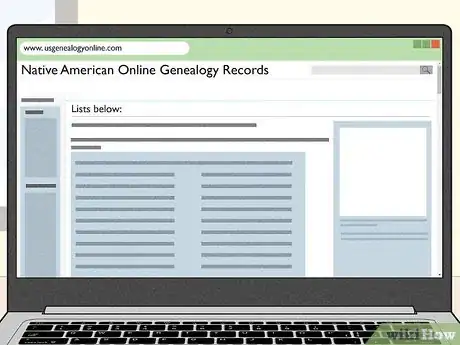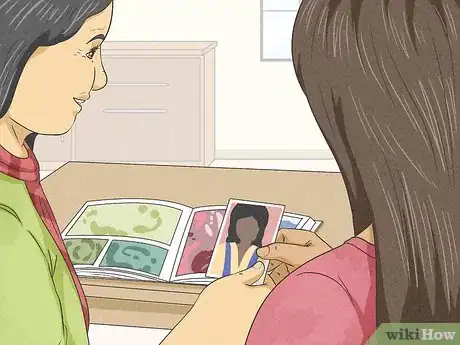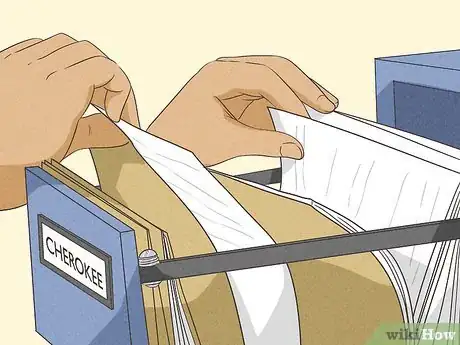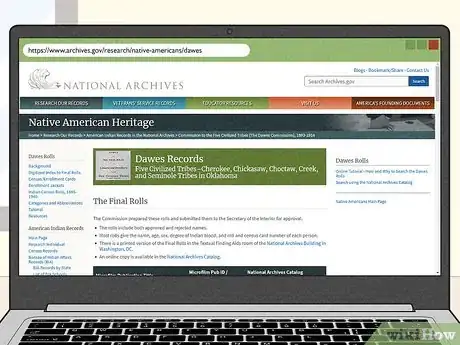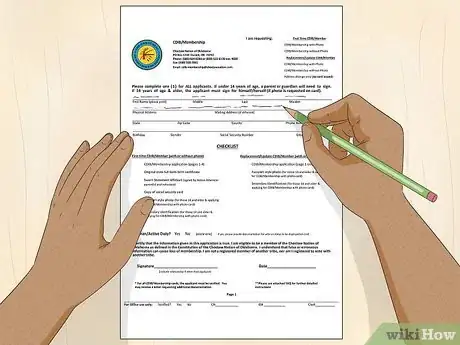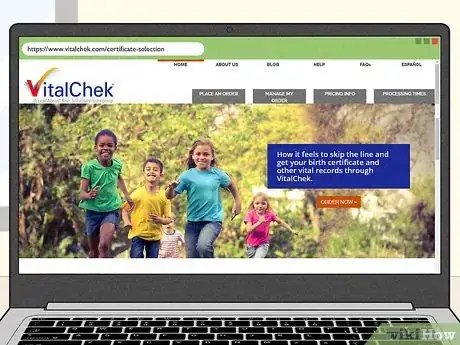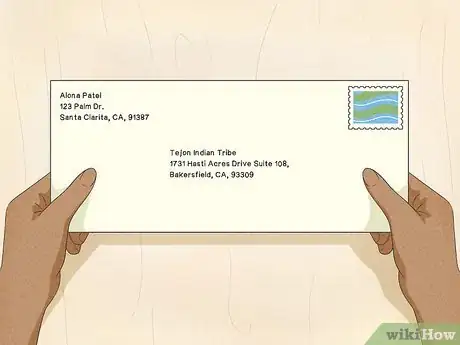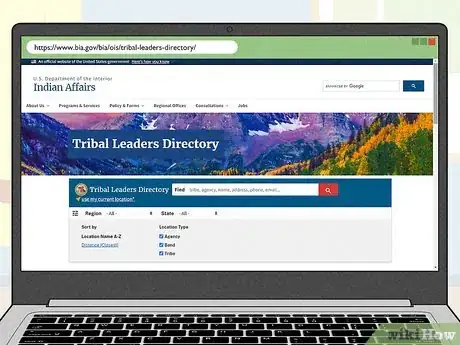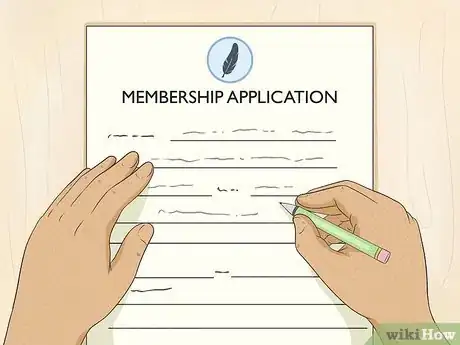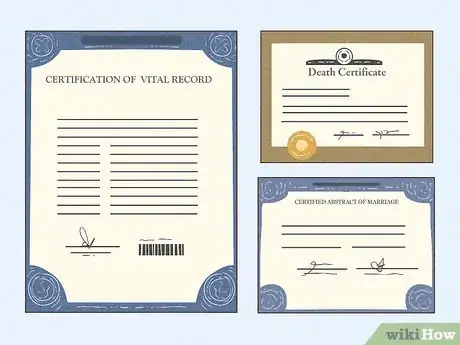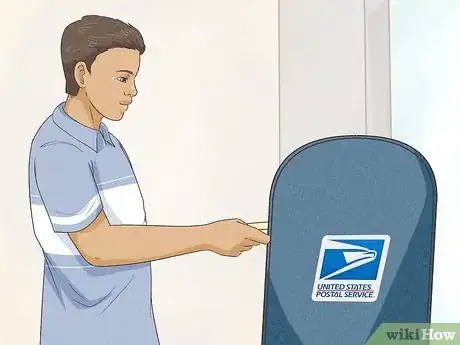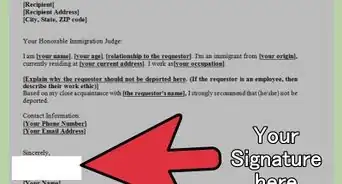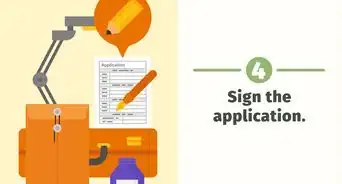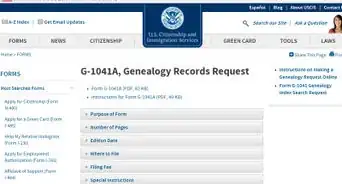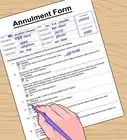This article was written by Jennifer Mueller, JD. Jennifer Mueller is an in-house legal expert at wikiHow. Jennifer reviews, fact-checks, and evaluates wikiHow's legal content to ensure thoroughness and accuracy. She received her JD from Indiana University Maurer School of Law in 2006.
wikiHow marks an article as reader-approved once it receives enough positive feedback. In this case, 100% of readers who voted found the article helpful, earning it our reader-approved status.
This article has been viewed 107,109 times.
If your family has lived in the United States for several generations, particularly if you have family located in Oklahoma or near reservations or tribal lands, it's possible that you are part Native American. If you want to register as a Native American, the process starts by locating an ancestor originally listed on the Dawes Commission Rolls. Once you've documented your lineage, you can apply for a Certificate of Degree of Indian Blood (CDIB) card from the Bureau of Indian Affairs (BIA). With a CDIB card, you are eligible to apply for tribal citizenship. However, each tribe has its own rules. Some tribes require a greater connection than ancestry alone.
Steps
Documenting Your Ancestry
-
1Set up an account on an online genealogy research service. Online genealogy research services provide tools that will help you access records and organize the information you find. While these services typically require you to purchase a subscription, many public libraries have accounts that allow you to access them for free and set up your own profile.[1]
- Online genealogy research services also may have access to digital records that you wouldn't be able to get otherwise. This can be particularly helpful with older records.
-
2Start with yourself and work backward through your family. Search for records dealing with your parents, then move on to your grandparents, great-grandparents, and so on. Closed adoptions may seem like a dead-end but there are ways you can work around them to trace your ancestry.[2]
- Keep in mind that if someone was adopted, their adoptive parents would not be considered your biological ancestors. You need to find their biological parents or other biological relatives, such as aunts or uncles, who can help you trace your lineage. Some adoption records also include information about tribal membership.
Tip: Home DNA testing services often allow you to connect with DNA relatives. This can help if you reach a dead-end because someone in your lineage was adopted. However, you'll only be able to connect with others that have also taken the same test.
Advertisement -
3Talk to family members about your Native American ancestry. Often, family stories will be the source of your belief that you have Native American ancestry. Digging into those stories can help you uncover details about family members that you may not have known. Those details, in turn, can help you fill out your family tree.[3]
- If you have access to older family members, they're more likely to have documents, photographs, and other information that may lead you to uncover the identity of your Native American ancestors.
-
4Check local court and other public records. You may not be able to fill out your full family tree online. Public records can help you connect ancestors, particularly those who lived locally. Many of these records required Native Americans to register their ethnicities.[4]
- For example, if you have an ancestor who was adopted, you may be able to find the court adoption order for them. That adoption order may include information about the tribe they came from.
- If you had ancestors who live in a different area, check the court's website or the state's public records office. You might be able to order records online or over the phone, which would save you a trip to search in person.
-
5Search for your ancestor on the Dawes Commission Rolls. Finding a Native American ancestor isn't enough if you want to register as a Native American. You must also be able to point to their name on the Dawes Commission Rolls. Many online genealogy research services have access to the Rolls.
- You can also access the Dawes Rolls on the National Archives website at https://www.archives.gov/research/native-americans/dawes.
- The Tulsa Library has a searchable index of the Dawes Rolls, as well as other resources for researching your Native American ancestry, at https://www.tulsalibrary.org/research/genealogy-center/american-indian-research.
Tip: You may find that you could potentially be a member of more than one tribe. In that case, you may want to go with the one that has a more recent ancestor or is easier to document.
Applying for a CDIB Card
-
1Fill out your CDIB card application. The CDIB card application requires you to recreate your family tree, tracing your lineage back to your Native American ancestors. If any of your ancestors were adopted, you will need to list the names of their biological parents if you know them. Include as much information as possible. Your application is more likely to be approved if you have complete information about your ancestors.[5]
- You may have ancestors who were enrolled in different tribes. If so, you must list each of these tribes on your CDIB card application. However, you can only apply for tribal membership with one tribe.
-
2Order certified copies of birth and death certificates for everyone listed. The family tree you create on your application must be supported by documentation. You can expect to pay between $15 and $30 for each certificate you order. These certificates will not be returned to you.
- Most birth and death certificates can be ordered online through the VitalChek service at https://www.vitalchek.com/certificate-selection.
- If there's a certificate you can't get online, check with the vital records department of the state where the person lived. The Centers for Disease Control and Prevention (CDC) maintains a list of state vital records offices at https://www.cdc.gov/nchs/w2w/index.htm.
Tip: It's a good idea to get marriage certificates as well, particularly if your Native American ancestry was acquired through marriage. These certificates are also available through the VitalChek system or state vital records office.
-
3Submit your CDIB application and supporting documents to the BIA. Once you have your certificates, mail them along with your completed application to the BIA Agency Office that serves your tribe. There are no fees to apply for a CDIB. It's a good idea to make a copy of everything for your records before you mail it.[6]
- BIA agency offices are included on the tribal leaders directory, available online at https://www.bia.gov/bia/ois/tribal-leaders-directory/. If you are potentially eligible for citizenship in more than one tribe, you'll need to pick the one you want to enroll in.
- If you need help figuring out which BIA agency office you need to send your application to, call the Office of Indian Services at 202-513-7640.
Tip: Some tribes allow you to apply for a CDIB card and tribal citizenship at the same time. In that case, you would mail your application and supporting documents to the tribal leadership, who would forward your information to the BIA.
-
4Wait for your CDIB to arrive in the mail. Once the BIA receives your application and supporting documents, it will initiate an investigation into your ancestry. Expect this process to take several months depending on the complexity of your family tree. Once the investigation is complete, you'll get a CDIB in the mail at the address you provided on your application.[7]
- Your CDIB card renders you eligible to apply for tribal citizenship. However, many tribes also require you to meet additional criteria before you will be awarded citizenship.
Obtaining Tribal Citizenship
-
1Search the tribal leaders directory. The tribal leaders directory, maintained by the BIA, provides contact information for the leadership of each of the federally recognized tribes. Scroll the list for the tribe that your ancestor was a member of to find the information you need.[8]
- The tribal leaders directory is available online at https://www.bia.gov/bia/ois/tribal-leaders-directory/.
-
2Contact the tribe to find out citizenship requirements. The federal government doesn't regulate citizenship requirements for the tribes. While some tribes only require the ancestry information contained in your CDIB application, others require additional work with the tribe or knowledge of tribal customs and rituals.[9]
- Most tribes have this information available on their website. Otherwise, you can write to the tribal leadership using the information you found in the directory.
Tip: Some tribes require you to live on tribal lands if you want tribal citizenship. If you're eligible for citizenship in more than one tribe, you may want to consider seeking citizenship from a tribe that doesn't have this requirement.
-
3Complete a membership application. Each tribe has its own application process, which typically begins with an application similar to the one you filled out to get your CDIB. However, depending on the citizenship requirements, you may have to provide additional information. Applications are typically available online or you can call the tribal leadership office and request a paper application in the mail.
- If you're eligible for citizenship in more than one tribe, you typically have to sign a form rejecting citizenship in any other tribe. Make sure you're applying for citizenship in a tribe you can prove your affiliation with and meet any other citizenship requirements.
-
4Provide documents to support your application. Just as you did with your CDIB application, you'll need birth and death certificates for each of the ancestors you listed on your application. You may also need marriage certificates or adoption orders. The tribal citizenship application will have a list of documents you're required to provide.[10]
- Some tribes accept photocopies, while others require certified copies. If you made photocopies of the documents you submitted to the CDIB, this can save you having to order additional certified copies.
-
5Submit your application to tribal leadership. Once you've completed your application and gathered your supporting documents, mail the entire package to the address listed in the tribal leadership directory. Before you mail it, make a copy of everything for your records.[11]
- You'll typically also have to include a copy of your CDIB card.
- You may want to mail your application using certified mail with return receipt requested, so you'll know when the tribal leadership has received your application package.
-
6Wait for the tribe's decision on your application. Each tribe has its own process for reviewing and considering applications for citizenship. Typically, the tribe conducts its own investigation into your lineage, then the tribal leadership votes on whether to accept your citizenship.[12]
- You'll typically receive a letter in the mail letting you know of the tribe's decision. Some tribes may require you to attend an interview with tribal leadership before your application is finally approved.
- Many tribes have ceremonies you can attend to be officially welcomed into the tribe. You'll also get information about any services you are now eligible for by virtue of your tribal membership.
Warnings
- While a blood test may establish that you have Native American ancestry, it cannot prove your ancestral lineage, your degree of kinship, blood quantum, or affiliation with a particular tribe. Blood tests are only useful if you are uncertain about whether you have any Native American ancestry at all, but are no substitute for genealogical research.[13]⧼thumbs_response⧽
References
- ↑ https://www.bia.gov/sites/bia.gov/files/assets/foia/ois/pdf/idc-002619.pdf
- ↑ https://www.bia.gov/sites/bia.gov/files/assets/foia/ois/pdf/idc-002619.pdf
- ↑ https://www.bia.gov/sites/bia.gov/files/assets/foia/ois/pdf/idc-002619.pdf
- ↑ https://www.bia.gov/sites/bia.gov/files/assets/foia/ois/pdf/idc-002619.pdf
- ↑ https://www.chickasaw.net/getattachment/a99f41c4-0c04-4fab-bef1-e648147e9a4b/Form_CDIB_App.aspx
- ↑ https://www.bia.gov/sites/bia.gov/files/assets/public/raca/online_forms/pdf/Certificate_of_Degree_of_Indian_Blood_1076-0153_Exp3-31-21_508.pdf
- ↑ https://www.bia.gov/sites/bia.gov/files/assets/public/raca/online_forms/pdf/Certificate_of_Degree_of_Indian_Blood_1076-0153_Exp3-31-21_508.pdf
- ↑ https://www.bia.gov/sites/bia.gov/files/assets/foia/ois/pdf/idc-002619.pdf
- ↑ https://www.doi.gov/tribes/enrollment
About This Article
To register as a Native American, you’ll need to prove your ancestry and apply for a Certificate of Degree of Indian Blood card. You’ll need to be able to draw your lineage on the Dawes Commission Rolls, which you can access through the National Archives or Tulsa Library websites. If you can’t trace your full family tree, check public records for your family’s birth certificates. For example, if you have an ancestor who was adopted, you may be able to find their court adoption order, stating which tribe they came from. Once you can prove your connection to Native American ancestors, fie an application for your Certificate of Degree of Indian Blood card with the Bureau of Indian Affairs. For more tips, including how to obtain tribal citizenship, read on!
